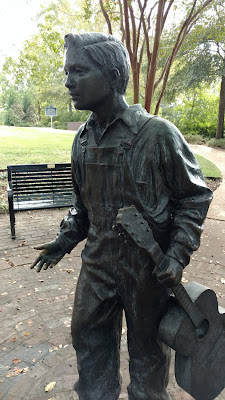October 20, 2018
Hi Blog!
We left Memphis behind and worked our way back east to rejoin the Natchez Trace near Tupelo, Mississippi. Once we made camp, we drove into Tupelo to visit the birthplace of Elvis Presley. When Elvis was 13, the family moved to Memphis. This museum is dedicated to the the early years before Elvis moved to Memphis.
Elvis Aaron Presley was born in Tupelo, Mississippi, on January 8, 1935, to Vernon and Gladys Presley. Born in a two-room house built by his father, grandfather and uncle, Elvis was one of twin brothers born to the Presleys. His brother, Jessie Garon, was stillborn. Elvis grew up in Tupelo surrounded by his extended family including his grandparents, aunts, uncles and cousins. This painting was based on a family photo that hung over the family's fireplace.
Despite being offered the chance to enlist in Special Services to entertain the troops and live in priority housing, Presley decided to serve as a regular soldier. This earned him the respect of many of his fellow soldiers and people back home who had previously viewed him in a negative light.
This is a model of the home Elvis was born in. Vernon Presley built this home in 1934 with $180 that Vernon borrowed from his employer. It was in this humble, two room house, lit by a single light bulb in each room, that Elvis Aaron Presley was born on January 8, 1935.
The Visitor's Center houses a small museum on Elvis' childhood. In 1946, Elvis's mother, Gladys, bought him a guitar for his birthday. Elvis could often been seen around town with his guitar in hand. In 1948, Elvis played his guitar and sang a farewell tribute to his Milam Junior High class before leaving Memphis.
Once Elvis' popularity began to grow, the City of Tupelo bought the house and some surrounding ground in 1957. Elvis wanted a park for the neighborhood children and donated the proceeds from a 1957 concert at the Tupelo Fairgrounds to further fund the project.
The house has been restored to what it would have looked like when Elvis was born. The only difference is the wallpaper. Back in 1935, it was common to paper the walls with newspaper. The fireplace is original. The family photo hangs over the mantle.
The stove in the kitchen is also original.
This bronze likeness of Elvis at age 13 was commissioned by the Elvis Presley Foundation. Elvis is portrayed in oversized overalls, a full open-collar shirt and plain shoes. The sculptor worked with photos to determine Elvis' facial features, hairline and general body size.
Elvis wanted to add a place of meditation to the Birthplace Park. In 1979, Elvis fans made that wish a reality when they raised the funds necessary to construct the Elvis Presley Memorial Chapel. It's hard to see, but the Presley home can be seen through the window behind the pulpit. The stained glass windows were designed specifically for the chapel. The Elvis Presley Fan Club helped purchase the pews. Today the chapel is a popular wedding venue.
The actual building where the Presley family attended church services was moved to the Birthplace Park. It was here that Elvis was first exposed to the rich, Southern gospel that became a staple of his musical repertoire.
As we walked into the plain, humble, wood-frame church, we were wondering how we were going to experience what Elvis experienced. We didn't have long to wait before three full length video screens descended from the ceiling. We were soon surrounded by a preacher, a choir and the entire congregation. The film re-enacted what it was like during a Pentecostal service in Tupelo, Mississippi. The three screens created a 270 degree view.
On the way back to camp, we drove through downtown Tupelo. Tupelo was incorporated in 1867, although the area had earlier been settled as "Gum Pond" along the Mobile and Ohio Railroad. On February 7, 1934, Tupelo became the first city to receive power from the Tennessee Valley Authority thus giving it the nickname "The First TVA City." Much of the city was devastated by a major tornado in 1936 that still ranks as one of the deadliest tornadoes in American history. Following electrification, Tupelo boomed as a regional manufacturing and distribution center and was once considered a hub of the American furniture manufacturing industry. Although many of Tupelo's manufacturing industries have declined since the 1990s, the city has continued to grow due to strong healthcare, retail, and financial service industries.
We found the downtown to be clean and well maintained. We didn't have enough time to explore further. We will have to put Tupelo on our list for "Next Time."












No comments:
Post a Comment
Note: Only a member of this blog may post a comment.